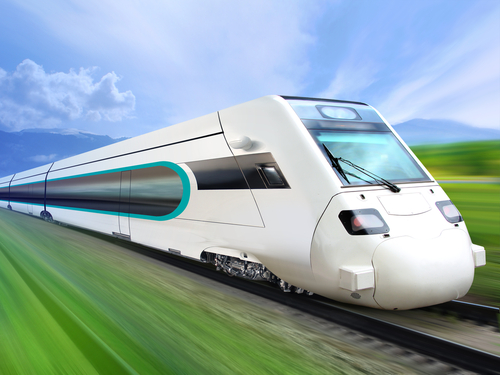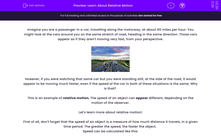Imagine you are a passenger in a car, travelling along the motorway, at about 60 miles per hour. You might look at the cars around you on the same stretch of road, heading in the same direction. Those cars appear as if they aren't moving very fast, from your perspective.

However, if you were watching that same car but you were standing still, at the side of the road, it would appear to be moving much faster, even if the speed of the car in both of these situations is the same. Why is that?
This is an example of relative motion. The speed of an object can appear different, depending on the motion of the observer.
Let's learn more about relative motion!
First of all, don't forget that the speed of an object is a measure of how much distance it travels, in a given time period. The greater the speed, the faster the object.
Speed can be calculated like this:

Think about this example. You are standing on a train platform, and a train slowly moves past you, travelling 20 metres in 10 seconds. What is the speed of the train?

Speed (m/s) = 20 m ÷ 10 s
Speed = 2 m/s
Now consider this - what if you were walking along the platform, in the same direction as the train is moving? Let's imagine that you are walking at 1 m/s.
How much faster than you is the train travelling? 1 m/s faster than you.
What does this mean? It means that the train is moving at 2 m/s relative to the train platform. And, the train is moving at 1 m/s relative to you.

The speed of an object can be measured compared to an observer. This is an example of relative motion. The speed of the train in our example depends on whether the observer is stationary or moving.
Here is another example. Once the train arrives, you get on, find a seat, and the train leaves the station. Let's imagine that the train is now moving at a speed of 20 m/s. How fast are you moving?
Relative to the tracks outside, you are moving at 20 m/s.
Relative to the seat you are sitting in, you are moving at 0 m/s!

Now let's imagine that a second train is travelling on the tracks next to yours, in the opposite direction. Both trains are travelling at 20 m/s.
The train heading towards you appears to be moving faster than 20 m/s.
Relative to you, the speed of the second train is the sum of the two speeds, so the relative speed is 40 m/s.
If two objects are moving towards each other, the relative speed is found by adding the speeds up.
If two objects are moving in the same direction, the relative speed is found by subtracting the speeds.
This can be a bit of a tricky concept, so well done for getting this far! Let's develop our confidence with some practice questions.








